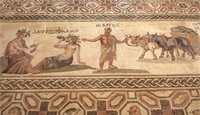
Palaepafos (Old Pafos), the “birthplace of Aphrodite”, was founded by King Kinyras, according to the tradition, while according to another legend, Agapenor was the founder of the city and the sanctuary. Paphos was one of the three city-Kingdoms of Cyprus, established after the end of the Trojan War.
Although the site was continuously inhabited from the Chalcolithic period to the present day, its most important period is at the end of the Late Bronze Age, when Mycenaean Greeks settled on the island, ca 1200 BC. The archaeological objects found illustrate the material culture of the newcomers at the beginning of the 12th century BC. In addition, the sanctuary of Aphrodite, also built in the 12th century BC, indicates a deeply-rooted tradition of fertility cult.
Nea Pafos (New Pafos), founded by Nikokles, the last king of Palaepafos, towards the end of the 4th century, became one of the main administrative centres of the area. There are still some important parts of its walls. During the 2nd century BC, the city became the capital of the island and reached the peak of its wealth. Many affluent residences, decorated with exceptional mosaics, belong to this era and show its spirit of wealth. The “Tombs of the Kings” reflect the wealth and sophistication of Hellenistic Pafos.
Paphos was inscribed on the World Heritage List in 1980 for two basic reasons:
- The role that the region of Pafos played in the worship of the goddess Aphrodite and
- The role that Cyprus, and Pafos more specifically, played in the spread of Christianity (especially the events associated with the passage Apostle Pavlos through the region)
More information: